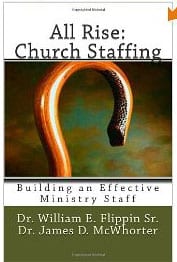 I am not an XP yet, but I do hope to be one when I grow up. In my pursuit of knowledge about the role and the many areas an XP has to keep track of, All Rise: Church Staffing—Building an Effective Ministry Staff has proven to be a great resource.
I am not an XP yet, but I do hope to be one when I grow up. In my pursuit of knowledge about the role and the many areas an XP has to keep track of, All Rise: Church Staffing—Building an Effective Ministry Staff has proven to be a great resource.
Dr. William E. Flippin, Sr. and Dr. James McWorther, the authors of All Rise: Church Staffing, have over sixty years of combined ministry experience. With a subtitle of Building an Effective Ministry Staff, you might expect to learn from their decades of service how to hire and lead a church ministry staff. Perhaps the book was inaccurately titled.
The authors give a mile-wide and inch-deep treatment of highly practical issues such as employee compensation, vacation times, tax issues, health and liability insurance needs, policies, sample forms and job descriptions. It is probably best that these issues are given such cursory treatment, seeing that details can change, dependent upon the state or presidential administration.
One chapter deals strictly with issues related to insurance. The authors list many examples of church property that should be insured—including aircraft! They give a good overview of different types of group insurance, from health to life. They also make a case for carrying “key person insurance,” to assist the church if something happens to their pastor or other significant people in the organization.
Another chapter deals with employee compensation. Although this area is not covered exhaustively, the reader will be better equipped to know what questions to ask a local HR professional after reading through the authors’ thoughts on establishing salary ranges and how to handle fringe benefits or paid time off.
Herein lays the strength of this book: For a person stepping into the role of Executive Pastor or Church Administrator, there is a great checklist of many of the administrative, human resource and church policy issues that one would face. From that perspective, all that is missing is an overview of finances and budgets. The sample forms, though dated, provide a great starting point for what might be needed in many contexts.
Unfortunately, the book is a bit dated. It shows its age when the authors wonder if the reader has heard of such terms as “information superhighway,” “cyberspace” or “the internet,” encouraging us to take advantage of this “new technology” by having a church website. The sample forms are dated as they offer the choice of whether you would want ministry event photos taken with color or black-and-white film. Film … what is that nowadays? The book is poorly typeset and poorly edited, with typos, grammatical errors and whitespace a plenty.
Despite its shortfalls, this is a good resource for the new or inexperienced Executive Pastor. It provides a great starting point for establishing good practices in many areas of church administration. While its prescribed methods may not fit the culture of every church, it will provide a helpful starting point for many.











